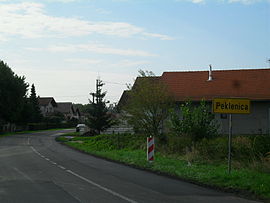Peklenica
| Peklenica | ||
|
|
||
| Basic data | ||
|---|---|---|
| State : |
|
|
| County : |
|
|
| Height : | 160 m. i. J. | |
| Residents : | 1,217 (2011) | |
| Telephone code : | (+385) 040 | |
| Postal code : | 40 315 Mursko Središće | |
| License plate : | ČK | |
 View of Peklenica |
||
Peklenica ( Hungarian Bányavár) is a village in the Međimurje County in northern Croatia . The name of the village comes from the name pekl (in German about "bad luck"). This is what the local population called the oil there. Since the territorial reorganization of Croatia, it belongs administratively to the city of Mursko Središće . Previously, Peklenica was assigned to the municipality of Čakovec . According to the 2011 census, the village has 1217 inhabitants. Croatians make up the largest proportion of the population .
The village runs at the foot of two hills and the regulated Brodec brook flows through its center. In the north of Peklenica is the Mur river . This also partially forms the border with Slovenia . To the east it borders on the town of Mursko Središće, about three kilometers away . To the west to the village of Križovec (approx. 1.5 km) and to the south to Vratišinec (approx. 2.4 km). The townscape is characterized by a more rural atmosphere. A country road runs through the village, the so-called “murska magistrala” (German for “Mur-Bundesstraße”). This connects the villages of Mursko Središće, Podturen and Sv. Juraj u Trnju, where it joins the national road D 20 connects.
Oil deposits
The village gained a certain degree of fame through its oil fields. Petroleum was made usable in Peklenica as early as 1856, a little earlier than in Pennsylvania (USA) , where the first worldwide data sets on petroleum come from.
In 1788, the chemistry professor Jakob Winterl from Budapest described a natural oil source near the Brodec watercourse. The first use of the oil occurred in 1856 and the first drilling took place in 1886. The mentions from the 19th century (1836) describe a dark brown color of the petroleum and a well that was only a few meters deep. Even back then, it was possible to extract around 20 kilograms of oil a day. The most important landowner at the time Juraj Festetić (1815-1883) was the first owner who had the oil excavated. On August 20, 1856, Festetić received a grave permit, which he renewed on August 10, 1860. Despite technical improvements, up to 1884 only up to 35 liters of crude oil were extracted every day. In 1886 Wilhelm Singer, a dealer from Vienna, then set up three drilling rigs in Peklenica. One drilling rig reached a depth of up to 350 meters, the other two were each 100 meters deep.
From 1932 to 1940 oil production in all of Yugoslavia was 5,884 tons, of which 4,098 tons were excavated in Peklenica alone. The oil excavation stopped in 1967 because it was no longer profitable. A museum about petroleum and mining is being built in Peklenica these days.
Individual evidence
- ↑ http://www.dzs.hr/Eng/censuses/census2011/results/htm/e01_01_01/e01_01_01_zup20_2763.html
- ↑ http://www.dzs.hr/Eng/censuses/census2011/results/htm/e01_01_04/E01_01_04_zup20.html
- ↑ http://www.ekomuzejmura.com/mursko-sredisce-peklenica.asp?l=d
- ↑ http://croatia.hr/en-GB/Representative-offices/United-States-Canada/30-Jul-2012/Peklenica-The-birth-place-of-the-petroleum-industry?bmlcMTg1MSxwXDc4MQ%3D%3D
- ↑ http://www.ekomuzejmura.com/mursko-sredisce-peklenica.asp?l=d

